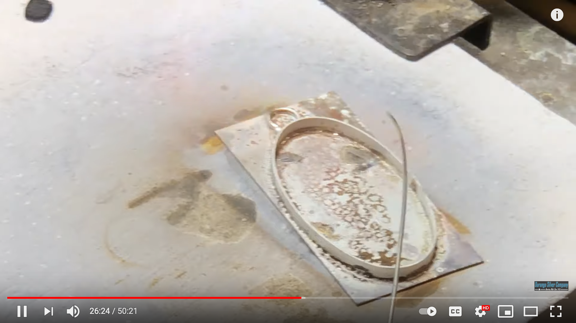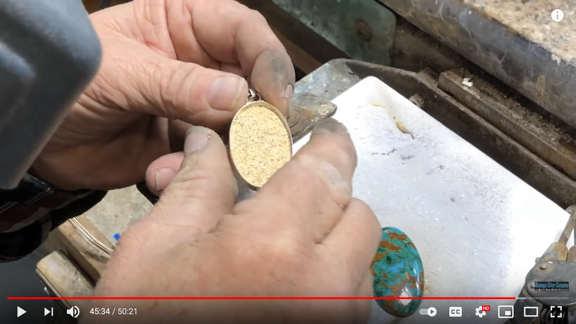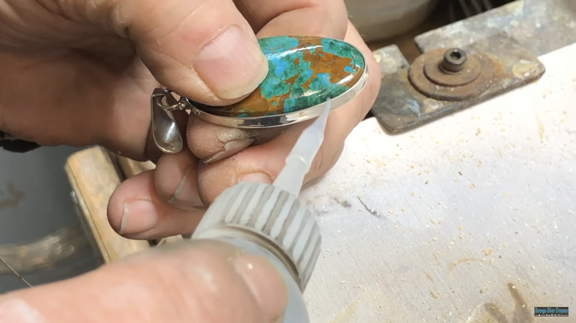I vent a little about people who should know better showing junk jewelry shortcuts in their jewelry-making videos.
I watch a lot of videos about making jewelry. I must have seen hundreds of them by now. Most were on YouTube, but I’ve also purchased in depth jewelry making videos on DVD or streaming services. I learn a lot from these and they can inspire me.
My favorite jewelry makers on YouTubeWant a few suggestions for getting started? Here are my top 5 favorite jewelry makers on YouTube:
- Soham Harrison. Soham makes no-nonsense videos that really teach techniques. His camera setup isn’t fancy but it does the job. Lots of his videos are great projects for beginners, but there’s some advanced stuff, too. Soham is based in Australia but his accent is American.
- Online Jewelry Academy. This one uses a set to record videos on a wide range of topics. The host, Professor John Ahr, is knowledgeable and a little weird. Lots of great videos for beginners here.
- Andrew Berry. Andrew Berry is another jeweler who teaches jewelry making. His videos cover a wide range of topics. I believe he’s based in the UK.
- Estona Metalsmithing. I recently discovered this channel and have watched quite a few of her videos. She seems to be making an effort to build up her subscriber base with quality tutorials. There’s a great beginner’s series and a bunch of other videos that go beyond the basic. She’s based in the Netherlands and speaks with a heavy accent, but her English is perfect. Just be aware that her terminology doesn’t always match the terms we use here.
- Rio Grande. Rio is a jewelry making supplier and they’ve got a bunch of videos that teach techniques, many of which are related to items they sell. While some are strictly marketing videos, there’s lot of good how-to material, too.
Before I go any further, however, I need to warn wannabe jewelry makers that there are a lot of crap videos out there. Videos that show you how to make junk jewelry or videos made by people who obviously don’t know what they’re doing and make videos out of their experiments. I also occasionally have trouble with the personalities (or voices, even) of some of the video makers. I have zero tolerance for people who spend more time talking about how smart they are than actually showing you how to make something great. And that woman who talks like Cindy Lauper? Sorry. I just can’t keep tuning in. So although I encourage you to watch videos to learn, be prepared to wade through a lot of crap to find gold.
All that said, yesterday I watched a video from Durango Silver, which is a well-known turquoise and jewelry seller seller based in Durango, CO. The video covered making a basic gemstone pendant and although I’ve seen dozens of videos on that topic and have made many of my own, I checked it out, hoping to learn a few new tricks.
The guy who was making the piece — John — definitely had experience and knowledge. His narration was better than average, but far from perfect — for example, he occasionally used the wrong word for something or left sentences unfinished as he was working. It amazed me when he started talking about how much he loved a particular pair of pliers, pointing out that they were made in Pakistan (like 75% of jewelry making tools) and struggling to get the name Wubbers out with a laugh. Why did that amaze me? Well, Wubbers is generally recognized as a quality brand of tool and I really think he should have been familiar with the name.
The camera work was excellent. Most videos are one-person affairs where the camera sits on a tripod that may or may not be in the best position; this video had a camera guy who did a great job staying focused (literally and figuratively) on what we needed to see.
The video was long — 50+ minutes — and I watched it on my new bedroom TV setup. That means I fell asleep before he was done. (I cannot read or watch TV in a horizontal position without falling asleep.) In the morning, however, I finished watching it on my iPad while I had breakfast. I did learn something — a new (to me) technique for attaching a bail — and, because of this, I consider watching the video time well spent.

Screen capture from the video showing John soldering the bezel and a jump ring to the back plate. One of the things I learned in this video was a new (to me) technique for using a jump ring to connect a pendant bail. He also demonstrated stick soldering, which I’ve seen a few times but haven’t tried yet.
That is, until I got to the end. You see, John was creating a bezel setting for a cabochon. A bezel is a strip of thin metal — silver, in this case — that is formed to fit the stone and soldered onto a back plate. When all the soldering and polishing is done, the very last step is to fit the stone into the prepared bezel and use a variety of tools to bend the top edge of the metal down around the stone to hold it in place. This is a standard bezel setting technique. Look it up, take a class, watch a bunch of bezel set videos and 99% of them will show you this correct way.
The video started going off the rails for me when John reached for a coffee mug full of sawdust and put some into the bottom of the finished piece, under where the stone would go. Sawdust. A wood product. In a piece of sterling silver jewelry.

Here’s another screen grab from the video. This one shows the layer of sawdust at the bottom of the bezel.
He then put the stone on top of it. The sawdust’s job was to raise the stone a bit so the bezel wouldn’t come up too high on the stone.
Let me take a moment to explain how getting the bezel the right height for the stone is usually done. There are two techniques to choose from:
- Before shaping and soldering the bezel, cut it to the right height. This is the correct way to do this. It’s a pain in the ass because you’re normally only trimming off a millimeter or two and it’s important to make a good, level cut. If your cut is bad, you can level it out with sandpaper after soldering it closed.
- Put something under the stone to raise it. Folks who do this normally use some sort of material that will not decay in any way. Tiny cut up pieces of credit cards are popular. I have, in the past, used copper sheet cut to size. (I once made a pair of earrings with bezel set cabochons and although the stones matched in appearance, one was definitely thicker than the other; I used copper under the thinner one to make it match its mate.) I’ve never seen anyone use a biodegradable product like sawdust.
Okay. So this guy used sawdust. He called it “jeweler’s sawdust.” I’ve never seen it before — and I’ve shopped at a lot of jewelry supply sites and stores. Maybe that’s acceptable in the business? I didn’t know but I also wasn’t going to switch.
What he did next, however, floored me. He pulled out a bottle of liquid glue and, using the needle-tip applicator, glued the stone into the bezel.

He called that stuff “superglue.”
I screamed at my iPad: “Not glue! Don’t fuck it up with glue!”
Of course, he kept gluing. I turned it off. I couldn’t bear to watch him permanently affix, with “superglue,” a beautiful cabochon to a very nice sterling silver setting and the sawdust beneath it with glue.
(I later watched the end. He did use a bezel setting tool to close up the bezel over the stone. But why the glue? Ugh.)
Later, I went back to look at the comments people had left on the video. Everyone loved it. Half of them said that they’d been wanting to try something like this and now they thought they were ready to do it.
I was horrified. He was teaching new jewelry makers a lazy way to do a bezel setting. A way that allowed makers to rely on glue instead of design and skills to set the stone.
But what was worse was that he was showing me that the jewelry made and sold by Durango Silver is likely held together with glue rather than the skill of the jewelry artist.
I guess the moral of the story is this: don’t just watch one video about how to do something. Watch a bunch. Pay attention to the details. If there’s a technique that most of the video makers are using, maybe it’s the right technique.
With very few exceptions, glue has no place in fine jewelry.



